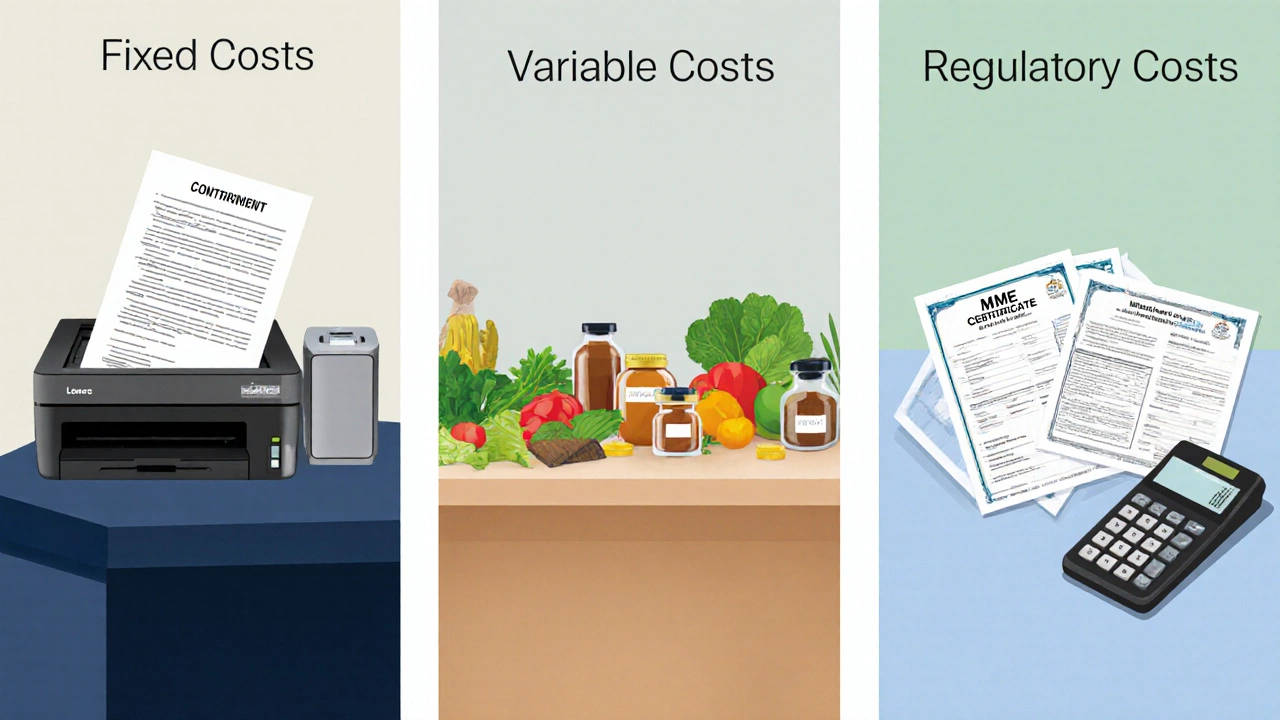₹10 Lakh Startup Budget Calculator
Business Type Selection
Quick Takeaways
- ₹10 lakh can cover many low‑cost ventures, but high‑tech or manufacturing startups often need more.
- Break down your budget by fixed, variable, and regulatory costs before deciding.
- India offers several government schemes - PMMY, Stand Up India - that can supplement a ₹10 lakh pool.
- Consider hybrid financing: self‑fund, micro‑loans, angel investors, or early‑stage VC.
- A solid cash‑flow plan and lean‑startup mindset are essential to stretch limited capital.
When you hear “Startup Funding in India is the capital you need to launch a new venture, whether it's a tea stall or a tech platform.” the question instantly becomes: is ₹10 lakh enough? The answer isn’t a simple yes or no - it depends on the industry, location, and how you allocate every rupee. This guide walks you through the math, the funding landscape, and the practical steps to make a ₹10 lakh budget work or tell you when it’s time to look for more cash.
Understanding the ₹10 Lakh Benchmark
First, let’s put the amount into perspective. ₹10 lakh (≈ US$12,000) sits comfortably above the average savings of an Indian middle‑class household but falls short of the typical seed round in major Indian tech hubs, which can easily top ₹50 lakh. However, for many low‑capex businesses - food carts, boutique retail, or service‑oriented startups - it’s a realistic starting point.
To decide if it’s sufficient, break the budget into three buckets:
- Fixed Costs: rent, equipment, licences.
- Variable Costs: inventory, salaries, utilities.
- Regulatory & Compliance: GST registration, MSME registration, tax deposits.
Below is a quick snapshot of typical expense ranges for three common startup categories.
| Business Type | Fixed Costs (₹) | Variable Costs (₹) | Regulatory Costs (₹) | Can 10 Lakh Cover? |
|---|---|---|---|---|
| Food‑Cart / Street Food | 2 - 3 lakh | 3 - 4 lakh (ingredients, staff) | 0.5 lakh (licences, GST) | ✓ |
| Co‑working Space (small) | 4 - 5 lakh (furniture, lease) | 1 - 2 lakh (marketing, utilities) | 1 lakh (legal, registration) | ~ |
| Tech SaaS Startup | 2 - 3 lakh (servers, software) | 4 - 6 lakh (developer salaries) | 0.5 lakh (company registration, GST) | ✗ |
Key Funding Sources to Bridge the Gap
If your calculations show a shortfall, India’s ecosystem offers several levers. Below are the most accessible options for a founder with ₹10 lakh in hand.
Pradhan Mantri Mudra Yojana (PMMY) provides micro‑loans up to ₹10 lakh for non‑farm entrepreneurs. The interest rate is market‑linked, and the application process is mostly paper‑free.
Stand Up India Scheme targets SC/ST and woman entrepreneurs, offering loans from ₹10 lakh to ₹1 crore for manufacturing or services businesses. The collateral requirement can be as low as 5% of the loan amount.
For tech‑heavy ideas, Angel Investors often look for a clear prototype and a team, putting in anywhere from ₹10 lakh to ₹50 lakh for an equity stake.
Venture Capital Firms typically enter at later stages, but some early‑stage funds (e.g., Indian Angel Network, Seedfund) have seed‑stage checks as low as ₹20 lakh, making them a stretch‑goal for a ₹10 lakh founder.
Traditional Bank Loans remain an option, especially if you can demonstrate cash‑flow projections. Public sector banks often have priority‑sector lending quotas for MSMEs, which can reduce the effective cost of borrowing.

Regulatory Must‑Dos Before You Spend
Skipping paperwork to save money is a common pitfall. Here’s a concise checklist to keep you compliant from day one.
- MSME Registration - unlocks lower tax rates and easier access to credit.
- Obtain a GST Registration if your annual turnover exceeds ₹40 lakh (₹20 lakh for services).
- Secure any sector‑specific licences (FSSAI for food, Shop‑Act licence for retail).
- Open a dedicated business bank account - many banks offer no‑maintenance‑fee accounts for startups.
- Set up basic accounting software (e.g., Tally, Zoho Books) to track cash‑flow early.
Each of these steps carries a nominal cost (usually under ₹10 000) but saves you from fines and delays later.
Real‑World Scenarios: When ₹10 Lakh Works and When It Doesn’t
Case 1 - The Neighborhood Bakery
Sanjay wanted a small bakery in Pune. He allocated ₹2 lakh for a used oven, ₹1.5 lakh for lease and interior, ₹2 lakh for initial raw material, and ₹0.5 lakh for licences. The remaining ₹4 lakh covered a modest marketing push and a six‑month cash‑reserve. Within three months, sales covered operating costs, and Sanjay reinvested profits to add a second oven. Here, ₹10 lakh was ample because the business was low‑capex and localized.
Case 2 - The Urban SaaS Platform
Riya built a B2B SaaS tool for inventory management. Development alone required ₹8 lakh for two junior developers and cloud services. Marketing, legal, and office space pushed the total to ₹18 lakh. Even after cutting non‑essentials, she needed at least ₹12 lakh to reach a viable product. Riya turned to an angel investor who provided ₹15 lakh for 12% equity, bridging the gap.
These stories illustrate the rule of thumb: if your fixed and variable costs stay under ₹7 lakh, you can bootstrap; beyond that, external funding becomes essential.
Strategic Tips to Stretch a ₹10 Lakh Budget
- Adopt a lean MVP: Build only core features, test with a small user group, iterate fast.
- Leverage co‑working spaces instead of a dedicated office - many offer daily passes for as low as ₹300.
- Barter services with other founders - e.g., exchange graphic design for bookkeeping.
- Use open‑source tools for development, marketing automation, and analytics.
- Apply for government grants - each state runs its own startup fund; Maharashtra’s “CM’s Startup Fund” offers up to ₹25 lakh.

Potential Pitfalls and How to Avoid Them
Even with a solid plan, several traps can eat your ₹10 lakh quickly.
- Over‑estimating revenue: Base cash‑flow forecasts on conservative numbers (e.g., 30% of expected sales in month 1).
- Neglecting working capital: Reserve at least 3‑4 months of operating expenses to survive slow periods.
- Ignoring tax compliance: Late GST filing incurs penalties of up to 10% of tax due.
- Choosing premium tools too early: Start with free tiers; upgrade only when revenue justifies.
- Skipping market validation: Conduct a 30‑day pilot before spending on branding.
Bottom Line: Making the Decision
Whether ₹10 lakh is enough hinges on three core questions:
- What is the industry’s typical capex?
- Can you keep fixed costs under ₹5 lakh?
- Do you have a clear path to generate cash‑flow within six months?
If you answer “yes” to all three, you can launch with confidence and treat external funding as optional growth fuel. If any answer is “no,” start scouting for the funding sources listed above before you burn through personal savings.
FAQ
What expenses consume most of a ₹10 lakh startup budget?
Typically, rent and equipment (fixed costs) take up 40‑50% of the budget, while inventory, staff salaries, and utilities (variable costs) account for another 30‑40%. The remaining 10‑20% covers licences, GST registration, and a small contingency fund.
Can a sole proprietor get a Mudra loan for a ₹10 lakh startup?
Yes. Under PMMY, individuals can apply for a Shishu (≤ ₹50 k), Kishor (₹50 k‑₹5 lakh), or Tarun (₹5 lakh‑₹10 lakh) loan. The process is online via banks or NBFCs, and collateral is optional for amounts up to ₹10 lakh.
Is GST mandatory for a startup with a ₹10 lakh turnover?
GST registration becomes mandatory once annual turnover exceeds ₹40 lakh for goods or ₹20 lakh for services. If you stay below those thresholds, you can operate as a non‑GST entity, but many startups register voluntarily to claim input‑tax credit.
How much should I keep as a cash reserve?
Aim for at least 3‑4 months of operating expenses. For a ₹10 lakh startup, a reserve of ₹2‑₹3 lakh helps you survive slow sales or unexpected costs.
What’s the fastest way to raise additional funds after the initial ₹10 lakh?
Pitch to angel networks or apply for the Stand Up India Scheme if you’re a woman, SC/ST entrepreneur. A well‑crafted pitch deck and early traction can secure an angel check of ₹15‑₹25 lakh within weeks.
In short, ₹10 lakh can be a solid launchpad for many Indian businesses, provided you keep costs lean, stay compliant, and tap the right funding channels when needed.
